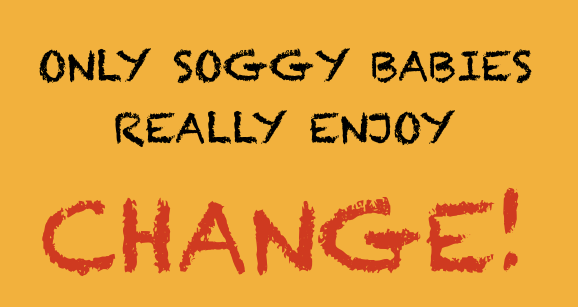Sustaining Change Needs 3 Powerful Essentials

Sustaining Change is easy. Isn’t it?
Sustaining Change gets experts talking: If you don’t like something, change it; if you can’t change it, change the way you think about it. Mary Engelbreit
Mike Pedlar wrote that short-term issues drive out the long; he went on …
‘weighing long-term consequences against short-term advantage can create moral dilemmas.’ Mike Pedlar
Suppose one lacks an ethical compass, a characteristic some may attribute to politicians. In such cases, the moral dilemmas created and ignored surely generate ever more cynicism in the people relied on to achieve and sustain beneficial Change.
This insightful quote reflects on the challenges of achieving sustainable Change.
We trained hard, but it seemed that every time we were beginning to form up into teams we would be reorganized. Presumably the plans for our employment were being changed. I was to learn later in life that, perhaps because we are so good at organizing, we tend as a nation to meet any new situation by reorganizing; and a wonderful method it can be for creating the illusion of progress while producing confusion, inefficiency, and demoralization. During our reorganizations, several commanding officers were tried out on us, which added to the discontinuity. Charlton Ogburn Jr., Harper’s Magazine, Jan 1957
I agree, especially considering three components essential to sustaining Change.
- Personal change
- Organizational Change
- National Change
Sustaining Change
Awareness of a need for Change is one thing and the ability to enact it effectively is quite another. Rules, policies and procedures are only words. They do not make a change at work happen. In an organizational setting, all the humans are needed for solid outcomes. Effective and committed people are required throughout.
A CEO I was doing Organizational Development for met with a team of executives. There were tensions in the air. He said disagree, and once we’ve decided, commit. Jeff Bezos has much the same attitude.
Is giving orders sufficient?
Diktat is not enough whatever politicians and boardrooms think. It’s easy to be decisive when the pain falls elsewhere, more so when being seen to ‘reorganize’ sends a signal (useless or not) that something is being done. However, policies don’t guarantee sustainable Change.
Task in hand
 The task of leaders is to prepare, respond and adapt with honesty, realism and sensitivity to what is happening.
The task of leaders is to prepare, respond and adapt with honesty, realism and sensitivity to what is happening.
How many leaders are capable of helping colleagues make the best of themselves in trying, unfair and ambiguous circumstances? Never mind achieving time-pressured ‘deliverables’ as well?
Is inhumanity all we have?
Is it possible that leaders tend to operate in brutal ways when they implement and drive Change at work? How many managers are unaware and careless of the true impact of Change on people as individuals, in teams and larger groupings?
Pull yourself together
Saying pull yourself together, as Elizabeth Taylor did, isn’t enough. One person’s annoying situation may be another’s momentous disaster and cause unhelpful reactions such as hostility.
Planning and other challenges
How many policies, instructions and procedures are implemented with expertise and an awareness of their organizational and human impact?
What depth of understanding about the situational reality and complexity provides a foundation for thinking? In what way are expert focus, objective and credible analysis incorporated? For example,how does political tinkering and inexperience make for an ever more flawed and failing outcomes (NHS, PPE, HS2)?
And, in the wings
When going about Change, we are meant to follow well-intentioned laws, policies and prescribed consultative processes. Why is it that conflict and disruption are often outcomes when Change begins?What other significant elements may be missed, misunderstood or unknown?
Must Change cause pain?
Is Change generally expected to cause more pain than happiness? Could it be that if we understand the human factors and know what to do, we can enhance cooperation and positive working together? Even in the darkest and most difficult of situations?
The following blog, in this Change series, considers employee reactions to Change. These add further insight into the realities of what we humans experience and feel. Could this be different to what our employers might wish or intend?
More to come!
I hope you have enjoyed this blog. There’s more to come.
4 thoughts on “Sustaining Change Needs 3 Powerful Essentials”